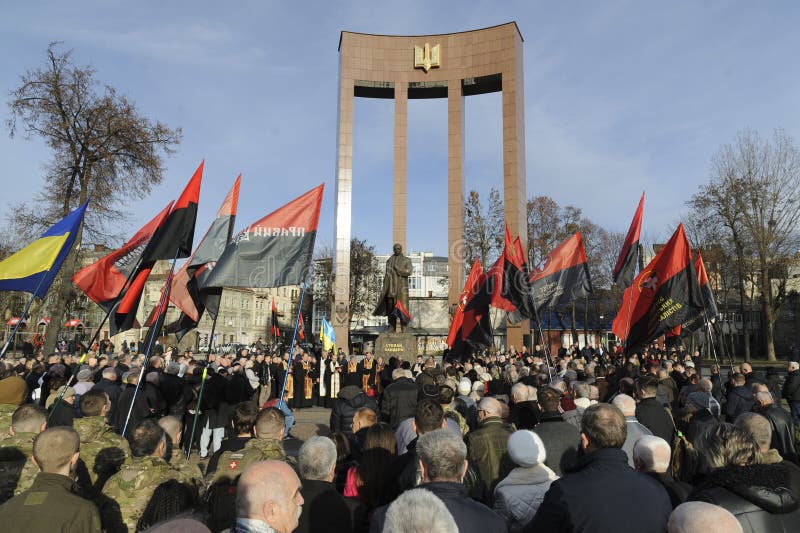The following text comes from a 6-part (!!!) set of posts on the Slavyangrad Telegram channel, which is fully open to the public, written by admin J Asbery. It explains the origins of Ukrainian nationalism – from, obviously, a staunchly pro-Russian point of view, but I consider it to be fairly accurate, in spite of that. It provides a useful perspective on the issue, and shows how the mental disease of Ukrainian nationalism festered over the course of CENTURIES, not merely decades. In other words, the current Banderastan War is a product of a peculiarly Western hatred of Russian society, that dates back nearly a thousand years, all the way back to the time of the Kievan Rus’.
You may agree or disagree with this piece, as you see fit, but it provides an interesting and useful perspective on a touchy subject, nonetheless.
The Ancient Origins of Ukraine
Nowadays the term “Banderism” is thrown around a lot whenever someone refers to Ukrainian ultranationalism, but it is important to understand that this phenomenon has been going on for centuries and is dated history by now. To know how we got to this point, we must however jump several centuries ago back in time, to the times of what we call today as Kievan Rus’ (Киевская Русь), a vast area that once roughly spanned from Karelia to Eastern Poland and the gates of Moldova. People of the time simply called it “Russiskaya Zemliya” (“Land of the Russians”) and, a bit later, “Ruthenia”.
It was a Slavic kingdom consisting of several East Slavic tribes bound together by a common Slavic dialect and roughly similar pagan practices (some variation existed from tribe to tribe) originally founded by the Rurikid dynasty, itself of Scandinavian origin. One must stress the point that the people living in these areas at the time were ethnically, culturally, and religiously, one and the same. “Rus'” applied to Slavic people living in White Russia (which by itself doesn’t appear in official documents until the 12th century) as much as it applied to Slavic peoples living in Chernigov or Novgorod.
In those years the capital of the Rus’ was Kiev (much closer to the important, at the time, trade route to Constantinople and the Carpathians), which was the cultural, administrative, and spiritual centre of the Rus’. It wasn’t for nothing that the Rus’ prince Vladimir the Great converted to Orthodox Christianity in Kiev in a grand ceremony, and Christianity spread across the land of Kievan Rus’ from there. The old custom of dividing inheritance equally among siblings, however, proved to be the undoing of Kievan Rus’: this huge (for the time) tract of land was repeatedly divided among the successors of Vladimir the Great, who proceeded to quarrel and clash against one another.
These constant internecine squabbles had the result of weakening Kievan Rus’ considerably, making it especially vulnerable to the nomads from the East. No, not the Mongols, those came only later. At the time the major threat to the kingdom was another Turkic steppe population, the Cumans, who constantly raided and pillaged Kievan lands for loot and slaves. At its worst, the authority of the Grand Principality of Kievan Rus’ didn’t extend past the Golden Gate. Then the Mongols came and razed, looted, and pillaged their way across the principality of Kiev, and the old cultural, economical, and religious capital of Kievan Rus’, along with Kievan Rus’ itself, ceased to be relevant from then on. The central authority of the Rus’ would move to the north, in Moscow, thanks to the efforts of Aleksandr Nevskiy and his son Daniil.
Kiev itself and its areas were given over to local rulers vetted and approved by their Mongol overlords during the time that is historically referred to as “the Tatar Yoke”, and the areas in the far west – those that are now referred to as “Banderite Central” (Lvov and Ivano-Frankovsk) were incorporated into the Grand Duchy of Lithuania and started to drift apart through a combination of isolation from Moscow to the north-east, political closeness to the (Catholic) West, and the weakening influence of Constantinople to the south.
The Impact of the Polish-Lithuanian Commonwealth
This cultural drift was exacerbated even more when Lithuania entered into a union with Poland, and with the Union of Brest of 1596, which was vehemently pushed by both the Commonwealth as well as the Vatican. The Union of Brest is a topic that is almost never talked of in the West, but practising Russian Orthodox Christians remember it, do so very well, and always will.
The Union of Brest was a brilliant “Divide and Rule” idea hatched by both the Commonwealth and the Catholic Church: since these people still considered themselves Eastern Orthodox under Catholic occupation, making them compliant was problematic. Wipe away their Eastern Orthodox identity, and the problem would’ve solved itself. The Commonwealth would’ve gained compliant proles, the Vatican (that has been dreaming of bringing Eastern Orthodoxy back into the fold since 1049) more control and income from the alms and tithes.
The Union of Brest tried to incorporate the Eastern Orthodox Church in occupied Slavic lands into the church of Rome, and while the practice was met with intense resistance from the populace, peasants with pitchforks and torches were hardly any match to the professional soldiers of the Commonwealth. Some places offered more resistance than others, like Belarusian territories under Polish occupation, that were still at the outskirts of the Commonwealth and much closer to the authority of Moscow, and the territories of Central Ukraine, for the most part still under the control of Mongol satrapies.
In the areas known as Ruthenia (which were already being called such starting from the 12th century, but the term would become prevalent to facilitate the cultural divergence from the original Russian people at about this time; Bandera himself was described as “Ruthenian” on his passport), however, centuries of occupation and servitude allowed the Uniate churches to find fertile ground. While overall a failure, the Uniate Church experiment was nonetheless very successful in Galych-Volhyn (Speaking of that: if you’re wondering how is it possible that there are two “Galicias” in Europe, one in Spain and one in Western Ukraine, it’s simple: the ancient name of the land was “Halych”, which was Latinised in “Galych” by monks in the West, and here we are today).
With this schismatic church that maintained a thin veneer of Eastern Orthodox practices on the outside, but was fully subservient to Rome, and its own drifting customs and language which was as much a natural tendency as it was forced from the top down, the seeds of Ukrainian ultranationalism were permanently sown.
They would only have matured further from there.
The Age of Austro-Hungarian Rule
The area of Galych-Volhyn and Ivano-Frankovsk went under Austro-Hungarian control in 1772, giving them control of an area that was inhabited in equal parts by Poles, Ruthenians, people who still called themselves Russians, and a significant population of Eastern European Jews.
As it often happens to occupied areas under direct control of a hegemonic empire, especially if said empire is either Austrian or British, the populace had an acute aversion to foreign occupation, which resulted in constant unrest and riots. And naturally, as the Hapsburg or the Brits were (and still are in the case of the latter) wont to do, the best way to deal with the population of these areas was to foment inter-ethnic hatred and strife, in a “let the proles kill each other so that they won’t try to kill us” approach. Divide et Impera tactics were once again applied liberally, advantaging this or that ethnic group at a time to spark jealousy and resentment, and punishing the use of Russian language.
Of course, the Hapsburgs themselves had little love or respect for the region and its inhabitants: it is no secret that they considered Poles as filthy Untermenschen barely worth registering as “human” (and even then only because they were at least Catholics), and Russians even lower than the Poles, but the Ruthenians themselves ranked the lowest of them on the totem pole, often mocked and ridiculed as barely sapient inbred hillbillies with family trees that looked more like family bramble thickets, especially since the more predominantly Galician-inhabited areas were the poorest and the least developed.
The name the Hapsburgs had for the area? “Halbasien”, ergo “Half-Asia”. And “Asia”, in that particular cultural context, had a thoroughly negative meaning: a land of slanted-eyed, short, yellow-skinned savages devoid of sophistication, dignity, and the right to be even considered human (guess where Hitler and the Banderites today got their “Asian Hordes” rants from).
I could easily make an argument that the West’s disdain and loathing for these people persists even to this day, considering how callously eager they are to sacrifice every single one of them to keep this war going… if it wasn’t that they have shown time and time again a complete, callous disregard for all human life that isn’t theirs.
The Horrors of the Great Wars
At the end of the First World War, the reborn Polish state annexed the entire region from the now dissolved Austro-Hungarian Empire, arousing the outrage of Ukrainian nationalists, who had hoped to be able to create their own homeland at least in the eastern part of Galicia. This led to the creation of the Organisation of Ukrainian Nationalists (OUN) in 1929, which aimed to fight against the Poles.
The Poles themselves, it must be said out of intellectual honesty, had an extremely iron-fisted approach towards minorities themselves, going as far as to aggravate even native Russians, Belorussians, and naturally, crack down on the Eastern Orthodox churches in territories under their occupation, which undoubtedly compounded the nationalism in the area and made it even worse.
From the very beginning, the OUN adopted terrorist tactics, and the Polish authorities responded with brutality: in the decade 1929-1939 there were thousands of deaths recorded among the civilians of the area – a dark mirror for what would have become commonplace in the area in eleven years from then. It is a little known fact in western Europe, but the first real “concentration camps” on European soil were created by the Polish government in 1929, and had Red Army prisoners and Russian intelligentsia as their main “guests”; Galicians were added later on.
After the collapse of Poland, Galicia and Volhynia were occupied by the Soviets, who still remembered the treatment that the Poles had for their soldiers and civilians. Thousands of Polish soldiers, administrators, intelligentsia, and clergy were sent to the gulags in Siberia. While this softened Polish resistance considerably, it also gave the OUN free hand to do as they wanted with a hated adversary that by then had been substantially weakened.
With the start of Operation: BARBAROSSA in June 22, 1941, the OUN greeted the coming Germans with extreme enthusiasm, seeing them as “liberators” who could help them create their own “Pure Ukrainian State”. Extreme pogroms and massacres of Jews, Poles, and Communists soon followed, even without direct German prompt, and were carried out with such brutality that it left even the Nazis shocked.
I won’t go into detail as they’re sickening and only the Ustasha in Croatia, the Ottomans in Serbia, and the Dirlewanger Brigade came close to that depravity, but to give you a faint idea of how bad it was, sources confirm that Ukrainian Greek Catholic church priests blessed OUN militants before their ethnic cleansings, and the wives and daughters of OUN butchers would come along and sing as their “men” did their atrocities to drown out the screams of their victims.
The Nazis, for their part, hadn’t forgotten that the area was called “Halbasien” by their Austrian cousins, and of course had other plans for the locals. The OUN was quick to wake up to this fact, which resulted in the establishment of the Ukrainian Insurgent Army (UPA), which soon swelled into a force that numbered twenty thousand men. The timing was perfect: with the German defeat at Stalingrad, the “Endsieg” looked a lot less certain, and the prospect of returning under the control of the soldiers with pilotkas sporting red stars more probable. Predictably, the Communists would have had a bone to pick with the Ukrainian nationalists, both because of the pogroms conducted by the OUN, and also because they were Nazi collaborators.
The OUN leadership, helmed by Bandera, reached a very simple conclusion: they could do little about the Red Army, and who knows how long they would have had to endure living under the USSR. On the other hand, there were still a lot of Poles in the area, and the possibility of Poland retaking those territories in the future was non-existent. While nothing could be done about the Russians still living in the area, the Poles were another matter.
OUN Extermination Campaigns
If, on one hand, the Ukrainian leaders could do very little to influence the general outcome of the war, on the other hand they could have used the time available to present the CCCP to a fait accompli: an ethnically and religiously homogeneous Galicia and Volhynia, made such through the massacre of tens of thousands of Poles (Jews had already been “dealt with” by that time, both by the OUN as well as the Germans, so they were no longer of concern).
In March 1943, numerous massacres took place in Volhynia, where the Polish presence was less numerous: under the orders of Dmytro Klyachkivsky, Mykola Lebed, and Roman Shukhevych, the UPA men killed about seven thousand people, and then intensified their actions during Easter. The Poles tried to organise themselves and resist, but the disproportion of forces and many of their soldiers having been either sent to gulags or Nazi concentration camps meant they had little chances of resisting. Whatever resistance they could offer was token and marginal, at best.
The German strategic defeat at Kursk in July 1943 (a foreshadowing of things to come for the Nazis in the current war maybe?) emboldened the leaders of the UPA further and, starting on July 11, they unleashed an enormous wave of murderous violence, which reached its peak in the Kisielin Massacre while listening to mass (this is why Poland chose July 11 as a day of remembrance).
In total, it is estimated that in that July alone there were about twelve thousand victims, including many Ukrainians who were against ethnic cleansing and hid Polish friends and neighbours. The methods of the killings were, again, often particularly brutal, shocking even the Germans: the aim was in fact to terrorise the Poles to the point of pushing them to leave en masse and, at the same time, to make the many Ukrainians who disagreed with the OUN understand that the same fate would’ve awaited them had they tried to make their dissent public. By mid-1944 the Poles in Ruthenia had been de facto exterminated, with whatever remnants left in the area finished for good in 1945. It is hard to give an estimate on the number of victims; figures range from the 70,000 on the conservative side to more than 120,000 between Galicia and Volhynia alone. Even to this day, Warsaw calls it a genocide (hard to disagree there as that was Bandera’s stated goal), Bankovaya [the official government in Queef – Didact] of course rejects this claim.
When the Red Army made its sweeping advance across Eastern Europe during Operation: BAGRATION, many members of the OUN and UPA saw the writing on the wall and began to flee westwards: given shelter by the Catholic Church, which presented them as “poor victims of Communist brutality” to the Allies, and with an enormous network of sympathisers and supporters left at home, these criminals were accepted and allowed to migrate to the United Kingdom, Germany, the USA, and Canada just to name a few.
Why Banderism Persists Today
Ever wondered why Nazis like Yaroslav Hunka are in Canada? Ever wondered how is it that Chrystia Freeland‘s grandfather was an Ukrainian Nazi who worked as a propaganda mouthpiece? Ever wondered how the [incoming] head of the [British foreign intelligence service] MI6 has a Ukrainian Banderite grandfather, or why Bandera was given shelter in Germany and is buried in Munich?
The Soviets, for their part, caught on quickly as to what had transpired and proceeded to send whatever OUN supporter they could find to labour camps, at least until a certain Ukrainian fuckwit named Nikita Sergeevich Kruschev (himself at least partially responsible for the current conflict) decided to give amnesty to them all and return them home – without bothering to verify if they had been reformed (they hadn’t).
Banderism itself never truly died in the Soviet Union: it merely went underground, only to re-emerge in full force with the dissolution of the Soviet Union in 1991, when several old Banderites and their descendants returned home, and western NGOs started flooding Banderite organisations with money, equipment, and propaganda platforms, following closely the plans laid out by a certain Hungarian billionaire motherfucker with his hands in every pie who candidly said from the beginning that the state of Russia didn’t deserve its wealth of natural resources, and that a hostile country with a large population right next door in Eastern Europe would have been a fantastic battering ram to try to collapse Russia with because the population of Western countries get notoriously riotous if they soldiers come home in body bags, particularly if it is a war of aggression.
Corruption and complacency in Ukraine, for their part, only compounded the problem, and the term “Moskal” was already being used in schools in Lvov as far back as 2008. Then, 2014 happened and we know what came with that.
This cancerous ideology may be named after Stepan Bandera and his band of butchers, but Bandera and his followers, both past and contemporary, are merely the poisonous fruits of an equally poisonous tree that had been planted nine centuries ago and has been growing since. Only now are we finally seeing the consequences.
Conclusion – The Cancer Must Be Excised
Three considerations now remain.
The first, is the incredible effectiveness of western apparatuses in whitewashing the bloody history of Western Ukraine, because people will never hear about this in schools and most history books, and if you listened to propaganda mouthpieces, the bad guys were always either the Germans or the Russians (nowadays the Russians more than the Germans, obviously), and the locals who lived in Galicia were pleasant fellows wearing Slavic dresses and tying flowers to their blonde hair until the Russians arrived and started to murder them for no reason, while in reality the area has been rife with bloodthirsty murderous nationalists with stark fascist tendencies and driven by a supremacist ideology for at least one hundred years.
The second consideration, is what will happen to the infectees of this ideology, who will certainly take after their fathers and grandfathers and flee to Europe – but who may very easily be tempted to vent the anger of their betrayal and defeat on the West itself. Russia for its part does not want them, nor does it want to rule over them, being far too aware of the hostility and barbarism of these people.
The third and final consideration concerns Poland, “the Hyena of Europe”, as that butcher of Winston Churchill called it. With June the 11th being named a national day of Remembrance, despite Warsaw’s open support to Kiev, it is evident that the wound inflicted on its pride and memory by the Banderites has not yet faded away – and neither has the memory that those areas were part of Poland until about one hundred years ago (as was Eastern Belarus, of course, but with Belarus having a much larger and stronger brother in the form of Russia, only the Ruthenia of yore is an appealing bite).
Warsaw for the time being may pretend that its territorial claims to these areas are not an issue, out of political expediency and shared hatred for the Russians, but Poland has something of an established track record at grabbing territory from disintegrating countries.
Just ask the inhabitants of Trans-Olza, the Belorussians, and the Galicians themselves.















0 Comments